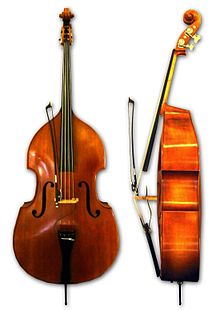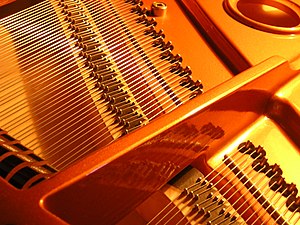String instrument
A string instrument (or stringed instrument) is a musical instrument that produces sound by means of vibrating strings. In the Hornbostel-Sachs scheme of musical instrument classification, used in organology, they are called chordophones. The most common string instruments in Western music are those in the violin, piano and guitar families.
Types of string instruments

- For a full list, see List of string instruments.
All string instruments produce sound from one or more vibrating strings, transferred to the air by the body of the instrument (or by a pickup in the case of electronically-amplified instruments). They are usually categorized by the technique used to make the strings vibrate. The three most common techniques are plucking, bowing and striking.
Plucking
Instruments such as the guitar, oud and sitar are plucked, either by a finger or thumb, or by some type of plectrum. This category includes the keyboard instrument the harpsichord, which formerly used feather quills (now plastic plectra) to pluck the strings.
Bowing
Bowed string instruments include the violin, viola, cello (of the violin family) and the double bass (of the viol family). The bow consists of a stick with many hairs stretched between its ends. Bowing the instrument's string causes a stick-slip phenomenon to occur, which makes the string vibrate.
Other bowed instrument are the nyckelharpa and the rebec. The hurdy gurdy is bowed by a wheel.
Striking
The third common method of sound production in stringed instruments is to strike the string with a hammer. By far the most well-known instrument to use this method is the piano, where the hammers are controlled by a mechanical action; another example is the hammered dulcimer, where the player holds the hammers. The piano is often considered a percussion instrument, since sound production through struck blows defines this instrument family; the proclamation that the piano is a percussion instrument has at times served as rhetoric for composers who relished sharp percussive effects.
A variant of the hammering method is found in the clavichord: a brass tangent touches the string and presses it to a hard surface, inducing vibration. This is a very inefficient method of sound production, yielding a very soft sound. The maneuver can also be executed with a finger on plucked and bowed instruments, where it gives equally soft results. Guitarists refer to this technique as "hammering-on".
Other methods
The aeolian harp employs a very unusual method of sound production: the strings are excited by the movement of the air.
Some string instruments have keyboards attached which are manipulated by the player, meaning they do not have to pay attention to the strings directly. The most familiar example is the piano, where the keys control the felt hammers by means of a complex mechanical action. Other string instruments with a keyboard include the clavichord (where the strings are struck by tangents), and the harpsichord (where the strings are plucked by tiny plectra).
With these keyboard instruments too, the strings are occasionally plucked or bowed by hand. Composers such as Henry Cowell wrote music which asks for the player to reach inside the piano and pluck the strings directly, or to "bow" them with bow hair wrapped around the strings, or play them by rolling the bell of a brass instrument such as a trombone on the array of strings.
Other keyed string instruments, small enough to be held by a strolling player, include the plucked autoharp, the bowed nyckelharpa, and the hurdy gurdy, which is played by cranking a rosined wheel.
Steel-stringed instruments can be played using a magnetic field. An E-Bow, for example, is small hand-held device which can be used to excite the strings of an electric guitar.
String length or scale length
This is the length of the string from nut to bridge on bowed or plucked instruments and ultimately determines the distance between different notes on the instrument. For example, a double bass with its low range needs a scale length of around 42 inches, whilst a violin scale is only about 13 inches. On the shorter scale of the violin, the left hand may easily reach a range of slightly more than two octaves without shifting position, while on the bass' longer scale, a single octave or a ninth is reachable in lower positions.
Contact points along the string

In bowed instruments, the bow is normally placed perpendicularly to the string, at a point half way between the end of the fingerboard and the bridge. However, different bow placements can be selected to change timbre. Application of the bow close to the bridge (known as sul ponticello) produces an intense, sometimes harsh sound, which acoustically emphasizes the upper harmonics. Bowing above the fingerboard (sul tasto) produces a purer tone with less overtone strength, emphasizing the fundamental, also known as flautando, since it sounds less reedy and more flute-like.
Similar timbral distinctions are also possible with plucked string instruments by selecting an appropriate plucking point, although the difference is perhaps more subtle.
In keyboard instruments, the contact point along the string (whether this be hammer, tangent, or plectrum) is a choice made by the instrument designer. Builders use a combination of experience and acoustic theory to establish the right set of contact points.
In harpsichords, often there are two sets of strings of equal length. These "choirs" usually differ in their plucking points. One choir has a "normal" plucking point, producing a canonical harpsichord sound; the other has a plucking point close to the bridge, producing a reedier "nasal" sound rich in upper harmonics.
Production of multiple notes
A string at a certain tension will only produce one note, so to obtain multiple notes string instruments employ one of two methods. One is to add enough strings to cover the range of notes desired; the other is to allow the strings to be stopped. The piano is an example of the former method, where each note on the instrument has its own set of strings. On instruments with stoppable strings, such as the violin or guitar, the player can shorten the vibrating length of the string, using their fingers directly (or more rarely through some mechanical device, as in the hurdy gurdy). Such instruments usually have a fingerboard attached to the neck of the instrument, providing a hard flat surface against which the player can stop the strings. On some string instruments, the fingerboard has frets, raised ridges perpendicular to the strings that stop the string at precise intervals, in which case the fingerboard is called a fretboard.
Modern frets are typically specially shaped metal wire set into slots in the fretboard. Early frets were cords tied around the neck, still seen on some instruments as wraps of nylon monofilament. Such frets are tied tightly enough that moving them during performance is impractical. The bridges of a koto, on the other hand, may be moved by the player, occasionally in the course of a single piece of music.
The middle Eastern string instrument the qanun, though it has many strings to give a selection of notes, is equipped with small levers called mandal that allow each course of multiple strings to be incrementally retuned "on the fly" while the instrument is being played. These levers raise or lower the pitch of the string course by a microtone, less than a half step. Similar mechanisms which change pitch by standard intervals (half-steps) are used on many modern Western harps, either directly moved by fingers (on Celtic harps) or controlled by foot pedals (on orchestral harps).
Sound production
Acoustic instruments
A vibrating string on its own makes only a very quiet sound, so string instruments are usually constructed in such a way that this sound is coupled to a hollow resonating chamber, a sounding board, or both. On the violin, for example, the taut strings pass over a bridge resting on a hollow box. The strings' vibrations are distributed via the bridge and soundpost to all surfaces of the instrument, and are thus made louder. The correct technical explanation is that they allow a better match to the acoustic impedance of the air.
It is sometimes said that the sounding board or soundbox "amplifies" the sound of the strings. Technically speaking, no amplification occurs, because all of the energy to produce sound comes from the vibrating string. What really happens is that the sounding board of the instrument provides a larger surface area to create sound waves than that of the string. A larger vibrating surface moves more air, hence produces a louder sound.
Achieving a tonal characteristic that is effective and pleasing to the player's and listener's ear is something of an art, and the makers of string instruments often seek very high quality woods to this end, particularly spruce (chosen for its lightness, strength and flexibility) and maple (a very hard wood). Spruce is used for the sounding boards of instruments from the violin to the piano.
In the early 20th century, the Stroh violin used a diaphragm-type resonator and a metal horn to project the string sound, much like early mechanical gramophones. Its use declined beginning about 1920, as electronic amplification came into use.
Electronic amplification
Most string instruments can be fitted with piezoelectric or magnetic pickups to convert the string's vibrations into an electrical signal which is amplified and then converted back into sound by loudspeakers. Some players attach a pickup to their traditional string instrument to "electrify" it. Another option is to use a solid-bodied instrument, which reduces unwanted feedback howls or squeals. Amplified string instruments can be much louder than their acoustic counterparts, which allows them to be used in relatively loud rock, blues, and jazz ensembles. Amplified instruments can also have their amplified tone modified by using electronic effects such as distortion, reverb, or wah-wah.
See also
- 3rd Bridge
- List of string instruments
- String instrument repertoire
- Luthier (maker of stringed instruments)
- Musical instrument
- Musical acoustics
- Strings (music)
- Vibrating string
- String orchestra
- Stringed instrument tunings
